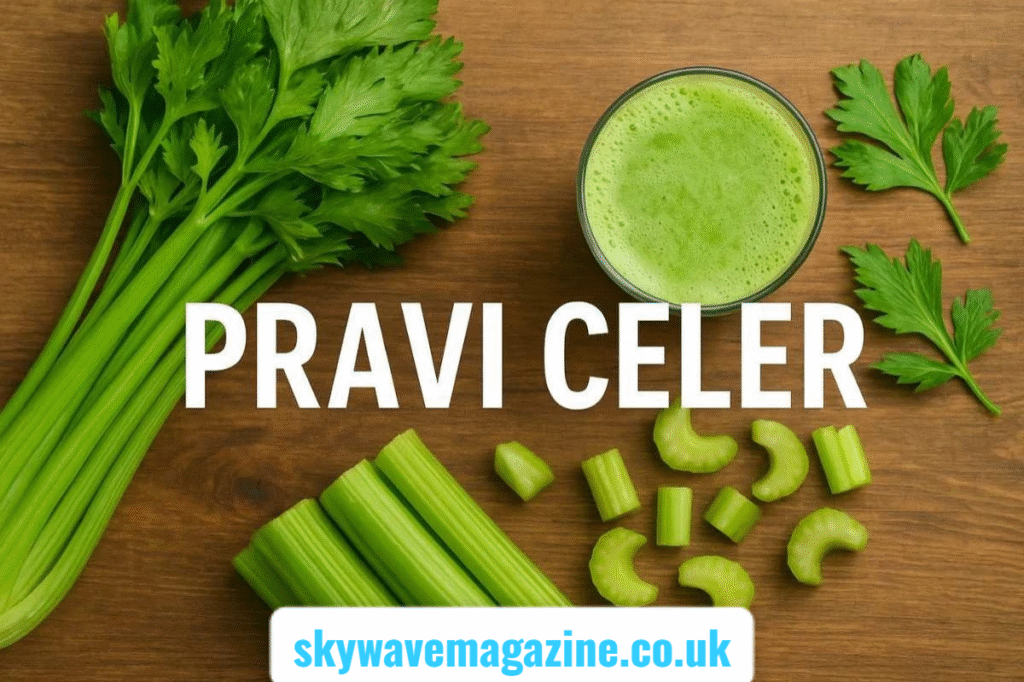
Pravi celer, or true celery, is a nutrient-packed vegetable recognized for its crisp texture and mild flavor. It is rich in vitamins, minerals, and antioxidants, promoting heart health, aiding digestion, and supporting overall wellness. Its culinary versatility allows it to be eaten raw, cooked, or juiced, making it an essential addition to a balanced diet.
This guide explores the benefits of true celery, a versatile vegetable celebrated for its crisp stalks and subtle taste. Beyond its culinary use, it supports digestion, reduces inflammation, and aids cardiovascular health due to its high fiber, potassium, and antioxidant content. Practical tips for cooking, juicing, and growing it at home are included, along with potential precautions. By understanding its nutritional profile, versatile applications, and health benefits, readers can incorporate this vegetable into daily meals effectively, enhancing flavor, hydration, and overall wellness.
Introduction: Discovering True Celery
True celery is a crisp, refreshing vegetable appreciated worldwide for its long fibrous stalks and aromatic leaves. Scientifically known as Apium graveolens, it belongs to the Apiaceae family and has been cultivated for centuries. Its mild flavor complements a variety of dishes, from salads to soups, and it can be consumed raw, cooked, or juiced. Nutritionally, it is rich in vitamins, minerals, and antioxidants, making it a practical choice for anyone seeking balanced nutrition and improved wellness.
Nutritional Composition
Celery is low in calories but provides essential nutrients, making it ideal for weight management. Each serving contains dietary fiber that supports digestive health and promotes satiety. It is a good source of vitamin K for bone health and vitamin C for immunity and skin care. Potassium is present to maintain heart and muscle function, and its high water content aids hydration. These nutrients make this vegetable a versatile and beneficial addition to a health-conscious diet.
Health Benefits
Incorporating celery into meals can improve overall wellness. Its antioxidants help reduce inflammation, while fiber aids digestion and regulates blood sugar. Potassium supports cardiovascular function, and vitamins help strengthen bones, enhance skin, and boost immunity. Regular consumption may assist with weight management, as it is filling yet low in calories. Additionally, the natural compounds found in stalks and leaves may have protective effects against chronic diseases, making this vegetable a practical choice for daily nutrition.
Bullet Points: Key Advantages
- Heart Support: Potassium helps regulate blood pressure naturally.
- Digestive Aid: Fiber promotes regular bowel movements.
- Anti-inflammatory: Antioxidants combat oxidative stress.
- Skin & Bone Health: Vitamins K and C enhance overall wellness.
Culinary Applications
This vegetable’s mild flavor and crunchy texture make it versatile. It can be added raw to salads for extra crispness, juiced for a nutrient boost, or cooked into soups, stews, and stir-fries. Leaves serve as garnishes or in seasoning blends. Celery sticks are also perfect for snacks with hummus or nut butter. Its adaptability allows it to enhance both flavor and nutritional value across a wide range of dishes.
Growing Celery at Home
Home cultivation of celery is possible with cool, moist climates and fertile, well-drained soil. Seeds can be started indoors before transplanting outdoors after frost. Consistent watering and fertilization encourage crisp, healthy stalks. Monitoring for pests like aphids or fungal issues is essential. Homegrown celery often has better flavor and nutrient density than store-bought, making it a satisfying project for gardeners and an excellent source of fresh produce.
Also read this: Gráinne Hayes: Leading Exercise Physiology and Health Research
Practical Daily Consumption
Adding celery to daily meals is simple. Begin the day with juice or smoothies, chop it into salads, stir it into soups, or enjoy as a snack with dips. Light cooking preserves nutrients, while overcooking may diminish health benefits. These practical steps allow the vegetable to support wellness while remaining a flavorful ingredient in everyday meals.
Bullet Points: Everyday Uses
- Raw Snacks: Sticks with hummus or peanut butter.
- Juices & Smoothies: Combine with leafy greens or fruits.
- Soups & Stews: Enhances flavor and texture naturally.
- Salads & Garnishes: Adds crispness and freshness.
Potential Precautions
While generally safe, celery can cause allergic reactions in some individuals, including itching or swelling. Excess consumption may lead to bloating due to fiber. It can also interact with certain medications, particularly blood thinners. Consulting a healthcare professional before large dietary changes is recommended. Being aware of these factors ensures safe and beneficial consumption.
Varieties of Celery
True celery differs from celeriac or leaf celery. It is grown for stalks, whereas celeriac is a root vegetable and leaf celery is primarily used for seasoning. Choosing the correct type ensures the best flavor, texture, and nutritional benefits. Recognizing these differences helps home cooks and health-conscious individuals select the right variety for specific culinary and dietary needs.
Celery in Traditional Medicine
Historically, celery has been used to manage blood pressure, inflammation, and digestion. Seeds, stalks, and leaves were incorporated into teas and tinctures. Modern research supports these traditional uses, emphasizing its antioxidants and anti-inflammatory properties. While it should not replace medical treatment, celery can complement a holistic approach to health.
Weight Management
Due to low calorie content and high fiber, celery is ideal for weight-conscious diets. Fiber promotes fullness, reducing overeating. Pairing celery with protein-rich dips or snacks enhances satiety. Regular inclusion in meals may support weight management while adding hydration and nutrients.
Hydration Benefits
Celery contains over 90% water, aiding hydration during hot weather or after exercise. Minerals like potassium support fluid balance. Incorporating it in salads, snacks, or juices contributes to overall hydration and wellness naturally.
Environmental and Seasonal Considerations
Celery grows best in cool climates with well-drained, fertile soil. Seasonal availability may vary, and locally sourced or homegrown options ensure freshness, support sustainable farming, and reduce environmental impact. Awareness of sourcing and seasonality enhances both taste and quality.
Conclusion
Pravi celer is a versatile, nutrient-rich vegetable that enhances both flavor and health. Its fiber, antioxidants, vitamins, and minerals support digestion, cardiovascular health, and overall wellness. Culinary adaptability allows it to be eaten raw, cooked, or juiced, while home cultivation provides fresh, flavorful options. Incorporating celery into daily meals is simple and highly beneficial, making it an essential part of a balanced diet for health-conscious individuals.
FAQs
1. What is pravi celer?
Pravi celer is true celery (Apium graveolens), recognized for crisp stalks and subtle flavor.
2. How can I use it in cooking?
It can be eaten raw, juiced, cooked in soups, stews, or used as snacks with dips.
3. Is celery healthy?
Yes, it provides fiber, antioxidants, vitamins, and minerals supporting heart, skin, and digestive health.
4. Can I grow celery at home?
Yes, with fertile soil, cool weather, consistent watering, and pest monitoring.
5. Are there side effects?
Allergic reactions or digestive discomfort may occur; moderation is recommended.
Fore more info: skywavemagazine.co.uk





